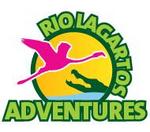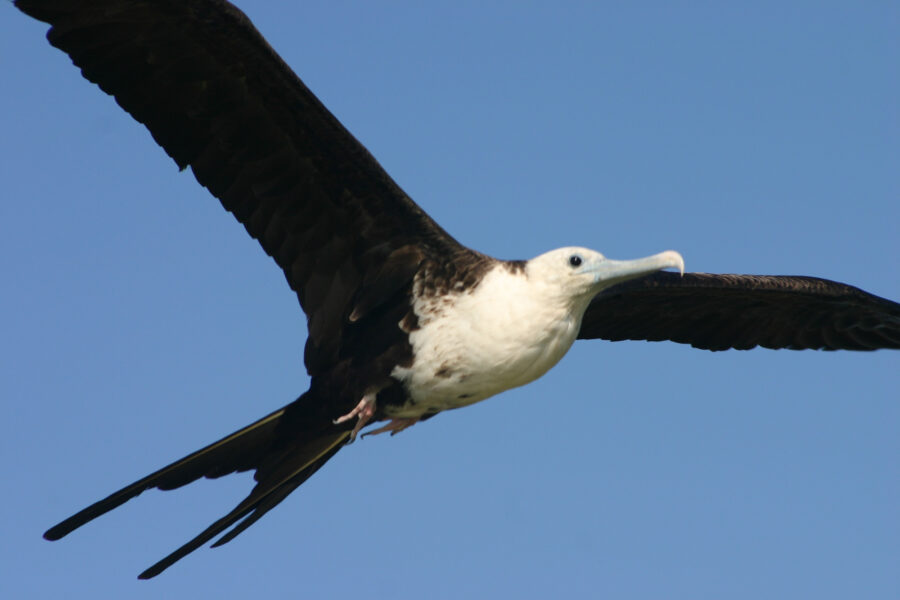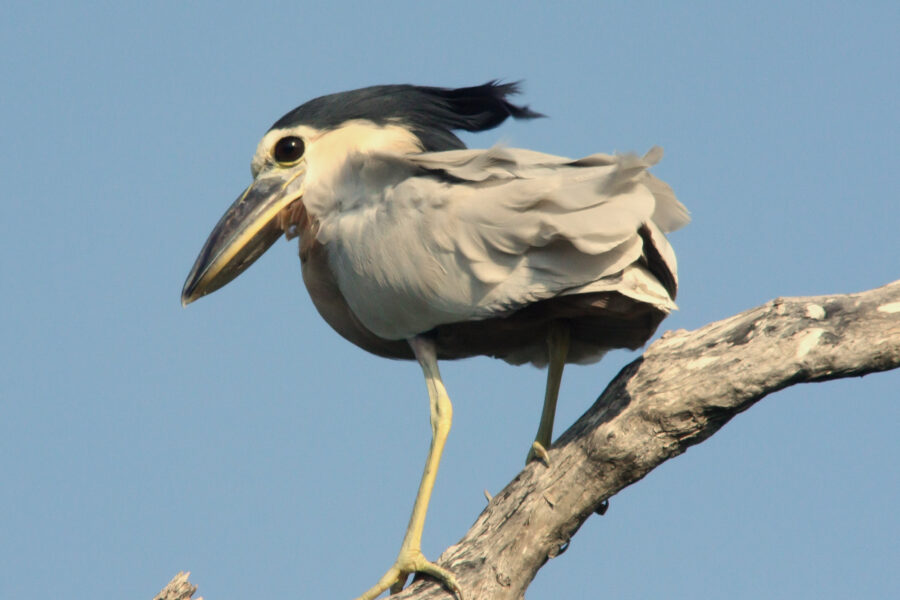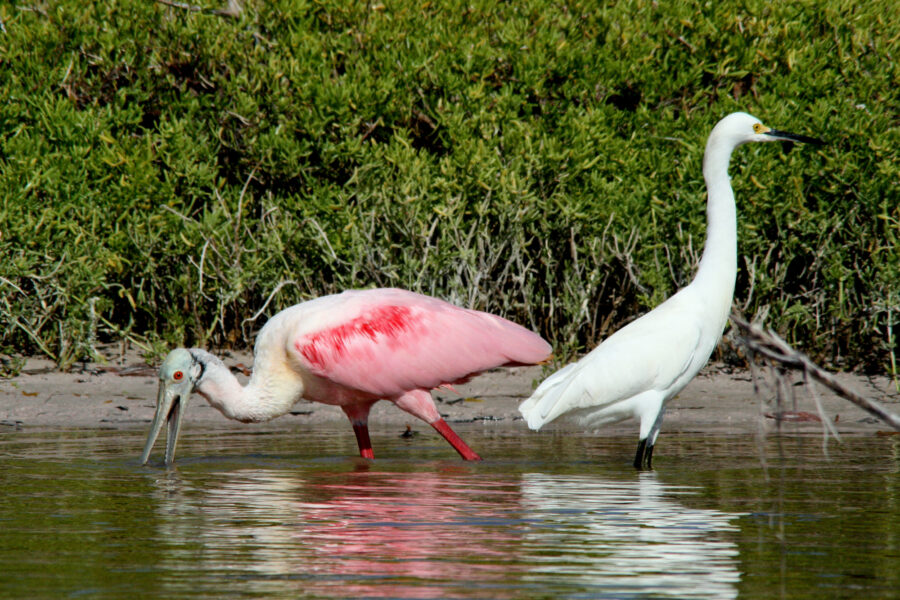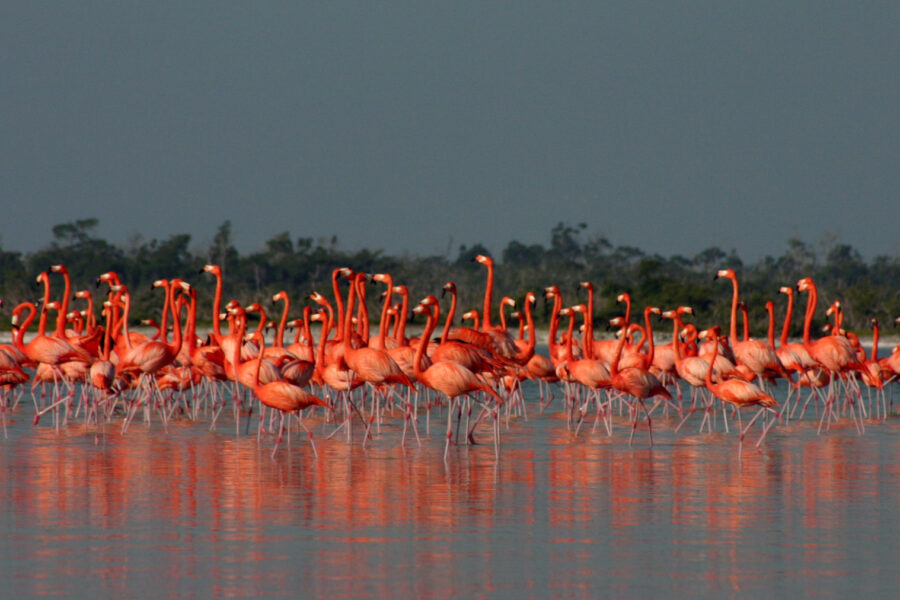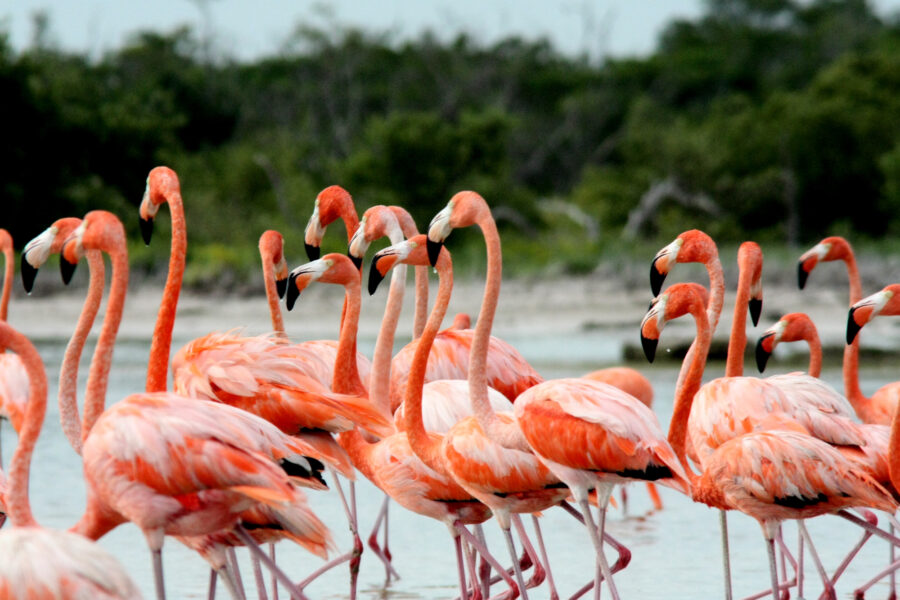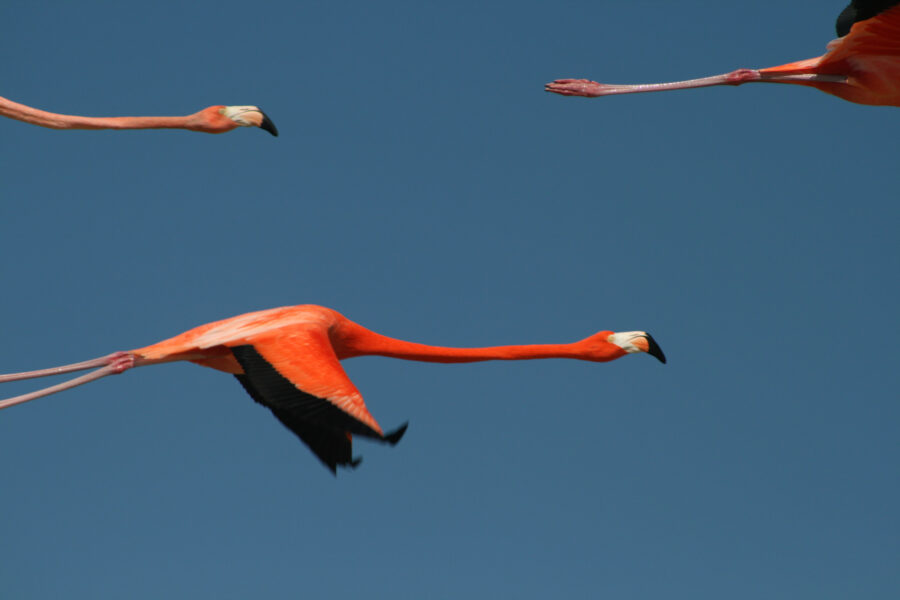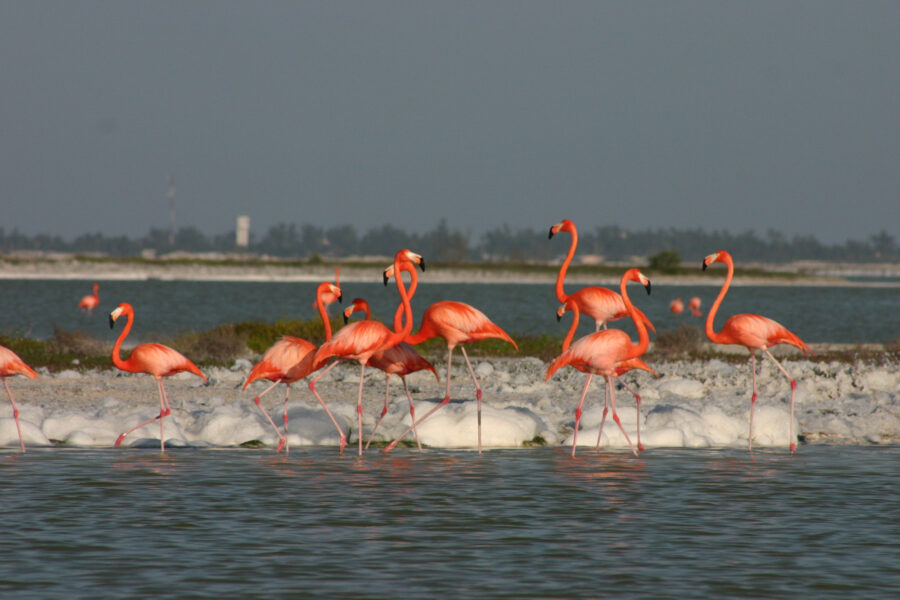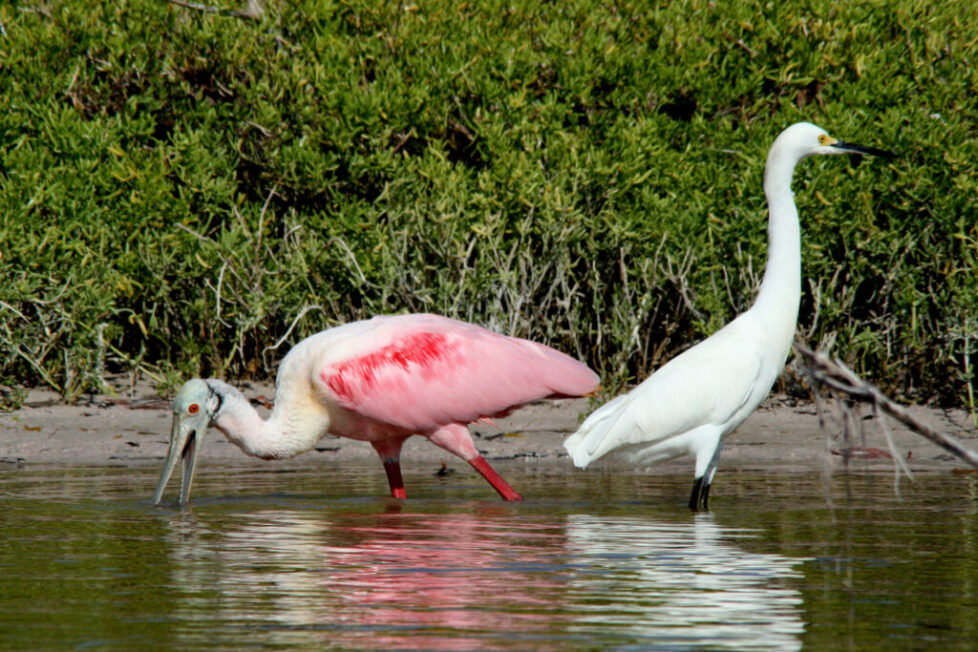
Rio Lagartos is best place for Birdwatching & Photography tours
on the Yucatan Peninsula..
Tours in the Ria Lagartos Bio Reserve with Diego Nuñez and Rio Lagartos Adventures
¨If you are looking for a one-stop location to see as many birds as possible while visiting the Yucatan Peninsula, the Ría Lagartos Reserve tops the list with 395 birds -70% of all the birds reported for the region.
The reason is simple: diverse habitats that include the sea, coastal dune, scrub, an extensive estuary, salt flats, fresh water wetlands, as well as both dry and humid forest.
On top of that, you have some of the best local bird guides in the region that know just where to find the birds on your “wish list”.
Barbara MacKinnon
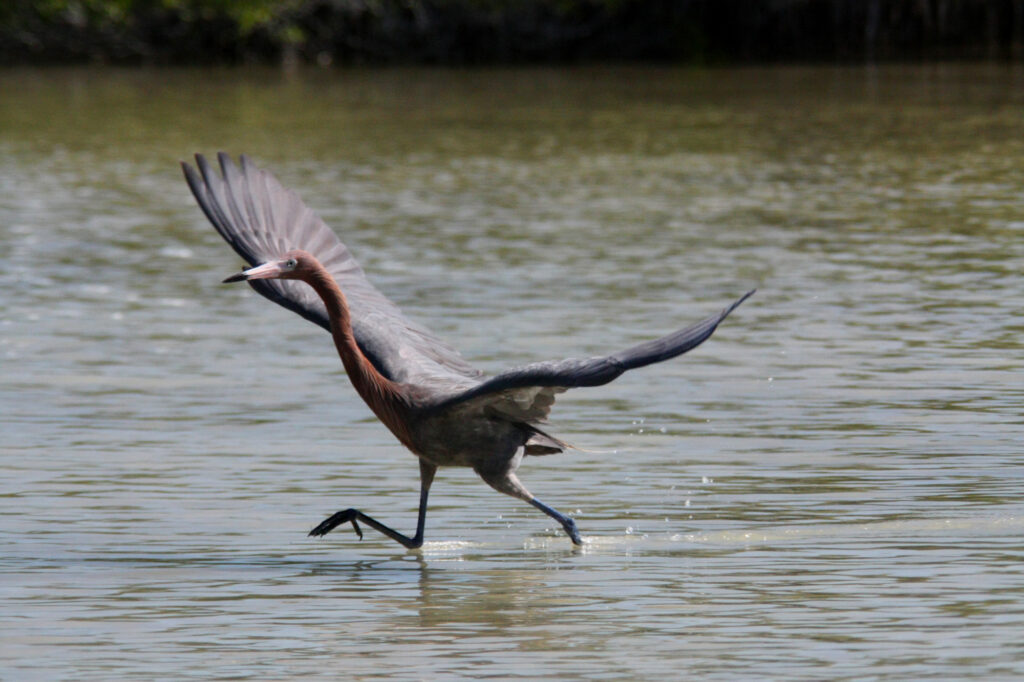
Less well known is the incredible birding we have here throughout the year.
If you are an experienced birder with specific birds to add to your lifetime list, a novice or just getting started, we can design your birding to match your skill and interest level.
If you are a photographer/birder we will help you find the species you are looking for and help get you close enough for a a chance at a good shot.
If you are a beginner we can offer bird identification lessons.
BIRD BIOGEOGRAPHY
in the Yucatán
ENDEMIC YUCATAN WOODPECKER
Barbara MacKinnon H.’s checklist of Yucatan Birds lists 537 species in 74 bird families. About 50% of all of Mexico’s bird species are found in the Yucatan and some 58% of all North American birds are found here. Some 128 species from North America regularly overwinter in the Yucatan, while some 54 species pass through the Yucatan during spring and/or fall migration, but nest farther north, and overwinter farther south than here. About 58 species are considered vagrants or occasional visitors. That’s a lot, largely because during fall migration, in September and October, the Yucatan is subject to tropical storms and “northers” that blow birds far from where they want to be.
The Yucatan birdlist contains a surprisingly high percentage of endemic birds — species that in the whole world are found only in the Yucatan. Barbara Mackinnon lists 14 species and about 100 subspecies.
THE YUCATAN’S
ENDEMIC BIRDS
Cozumel Island off Yucatan’s eastern coast is home to three species found nowhere else on Earth:
Cozumel Emerald
Cozumel Vireo
Cozumel Thrasher
The following species are found only in the bioregion comprising the Yucatan Peninsula, parts of Belize, northern Guatemala and western Tabasco.
Ocellated Turkey
Yellow-lored (Yucatan) Parrot
Yucatan Poorwill
Yucatan Nightjar
Red-vented (Yucatan) Woodpecker
Yucatan Flycatcher
Yucatan Jay
Yucatan Wren
Black Catbird
Rose-throated Tanager
Orange Oriole
The reason for so many endemics is easy to understand. Unique species tend to evolve on islands where gene flow from surrounding populations is cut off, allowing island-bound birds to evolve to their own local conditions. The Yucatan Peninsula is an “ecological island.” It is surrounded by water in the east, west and north, and, in the south, the moist, lush forests and marshes found there are ecologically very different from the arid north. To Yucatan birds adapted to dry, scrubby environments, the tall, humid forests of the south are nothing less than ecological walls. You may want to review our Vegetation of the Yucatan Page where we discuss the Yucatan’s rainfall patterns.
If you only stay in northern, inland Yucatan, you’ll miss a very large percentage of the birds on the Yucatan checklist. That’s because the southern Yucatan with its much greater rainfall and consequent more luxuriant vegetation has a considerably higher species diversity than the north — not only for birds but also for trees, wildflowers, reptiles, insects, and just about everything else. This make sense because we all know that deserts have fewer species than rainforests. On the other hand, often desert organisms are fabulously interesting because of their remarkable adaptations to very difficult conditions.
In fact, if you thumb through the distribution maps of birds found in the Yucatan again and again you’ll see maps similar to those shown below — forest-loving birds with distributions coming up from the southeast, and grassland- or scrub-loving birds with distributions mostly in the northwest.
Maps redrawn from Howell & Webb’s A Guide to the Birds of Mexico & Northern Central America
Of course, if you visit northern Yucatan’s coastal wildlife reserves, then species diversity skyrockets, for in those marshes and estuaries there is plenty of water. However, in the coastal reserves — Celestún, Río Lagartos and elsewhere — many of the shore, marsh and open-water birds are the very same species you’ll see in coastal Louisiana, Florida, and farther north along North America’s coasts. However, in these marshes there will be a few spectacular species you won’t see farther north, such as the flamingos, plus there are other kinds of plants and animals definitely not found in North America.
MANGROVES OF RÍA LAGARTOS BIOSPHERE RESERVE
Though in other parts of the world it may be different, in the Yucatan Peninsula four tree species are said to constitute the mangrove ecosystem. Click on the following names to see and read about each species:
The word “mangroves” refers to a special community of plants and animals occurring in tropical and semitropical zones that are inundated permanently or occasionally with saltwater. You find mangroves intermittently along all the Yucatan’s coasts and surrounding islands. Few ecosystems are as rich in species and shear numbers of living things, and are so important to the broader ecological community as mangroves.
However, mangroves are also very fragile. They are vulnerable to hurricanes, human drainage programs and “development.” In many tropical countries, including Mexico, mangroves are being destroyed to make way for urban expansion, hotels and beach-front homes.
MANGROVES ANCHOR THE SOIL
Mangroves protect an exceptionally vulnerable part of the coastal ecosystem: That part of the land between the low tide and high tide marks. Most of the time this land quietly bakes and simmers beneath the tropical sun, but when storms come — especially hurricanes — mangrove species hold the land together.
Without them the storm surge would reach far deeper inland. Without them, barrier islands might be completely scoured away. The picturebelow shows roots and stems of the Red Mangrove forming a tangle capable of breaking up or at least slowing down all but the biggest of storm waves that might crash into them.
Mangroves also maintain water quality and clarity by filtering pollutants and building the land by trapping sediment that otherwise might wash into the sea.
Other plants to look for in Ría Lagartos Biosphere’s mangrove ecosystems:
(click names to see and read about)
- Sea Purslane: Sesuvium portulacastrum
- Poisonwood— Metopium brownei
- Salicornia: Salicornia virginica
- Saltwort: Batis maritima
- Congo Mahoe — Hibiscus clypeatus
- Cattail: Typha domingensis
MANGROVES SUPPORT WILDLIFE
The mangroves’ tangle of roots and stems provide protected nursery areas for shrimp and other crustaceans, mollusks, and fishes. Thus they are critical for the commercial and recreational fishing industries. Huge numbers of migratory birds occupy the mangroves.
Special birds in Ría Lagartos’s mangroves:
- Clapper Rail
- Rufous-necked Wood-rail
- Mangrove Cuckoo
- Mangrove Vireo
- Kingfishers (Belted, Green & Pygmy)
PETÉN ECOSYSTEMS OF RÍA LAGARTOS BIOSPHERE RESERVE
Green, island-like clusters of trees — the petén ecosystems — speckle the marshy, grassy, frequently innudated lowlands at the far end of the estuary, at the eastern extreme of the biosphere reserve.
A petén is an island of trees of various kinds surrounded by marshy or swampy wetlands where trees are lacking. In our area, often a petén may occur in open, freshwater ponds or on a mound. Many plant species might be found in a petén, but here is a list of those most commonly found.
Characteristic plants of petén ecosystems
(click on names to see them and learn more):
CENTER OF A MOUNDED PETÉN:
MIDDLE GROUND OF A MOUNDED PETÉN:
PERIMETER OF A MOUNDED PETÉN:
ANIMALS IN THE PETÉN:
- Spider Monkey
- Collared Trogon
- King Vulture
- Jabiru
- Creaser’s Mud Turtle
- Red-eared Turtle
ROADSIDE PLANTS OF RÍA LAGARTOS BIOSPHERE RESERVE
WITH NATURAL MANGROVE IN THE BACKGROUND, THERE’S REDDISH SEA PURSLANE UP FRONT GIVING WAY TO YELLOW-FLOWERED NARROWLEAF YELLOWTOP
NOTE: Sometimes natural vegetation grows right up to the pavement, so “roadside vegetation” is what’s typical of the surrounding wild landscape. For example, sometimes mangroves grow along the road, with plants described in our mangrove section. Plants listed on this page are “weedy” — species typical of places where natural vegeation has been removed, the soil disturbed, and there’s plenty of sunlight and wind.
VARIOUS PLANT FAMILIES:
- Beach Gentian (Eustoma exaltatum)
- Coastal Spiderlily (Hymenocallis littoralis)
- Flatsedge, Rusty (Cyperus odoratus)
- Goatweed (Capraria biflora)
- Lantana (Lantana camara)
- Nightshade, Mullein (Solanum donianum)
- Purslane, Sea (Sesuvium portulacastrum)
- Salicornia
- Solanum tridynamum
- Spurge, Caribbean Sea (Euphorbia mesembrianthemifolia)
- Yellowtop, Narrowleaf (Flaveria linearis)
- Baybean (Canavalia rosea)
- Mangrove Vine (Rhabdadenia biflora)
- Teabush (Melochia tomentosa)
- Waltheria (Waltheria indica)
COMPOSITE/ DAISY FAMILY
- Ageratum, Gaumer’s (Ateratum gaumeri)
- Butter Daisy (Melampodium divaricatum)
- Feverfew (Parthenium hysterophorus)
- Porophyllum punctatum
- Stick-Tight (Bidens alba)
- Sunflower Goldeneye (Viguiera dentata)
- Yellowtop, Narrowleaf (Flaveria linearis)
GRASSES
- Bur-Grass, (Cenchrus brownii)
- Coastal Sandbur (Cenchrus spinifex)
- Cordgrass, Sand (Spartina bakeri)
- Couch Grass, Sand (Sporobolus virginicus)
- Crowfoot Grass, Egyptian (Dactyloctenium aegyptiuma)
- Elephant Grass (Pennisetum purpureum)
- Feather Finger-grass (Chloris virgata)
- Foxtail, Perennial (Setaria parviflora)
- Guinea Grass (Panicum maximum)
- Indian Bluegrass (Bothriochloa pertusa)
- Panicgrass, Tropical (Panicum trichoides)
- Sandbur, Coastal (Cenchrus spinifex)
- Setariopsis auriculata
MARSHES
OF RÍA LAGARTOS BIOSPHERE RESERVE
Yucatán, México
Marshes such as the one above have water that may be permanent or missing during the dry season. The vegetation is dominated by low shrubs and herbaceous members of the Grass and Sedge Families. The deep soil is clayey, containing much organic material.
The water is brackish to fairly sweet. If storms or high tides have flooded an area with seawater, it’ll be more brackish. If the area recently was dry, but now rains have filled the low areas, it’ll contain little salt, though salt residue in the soil from past floodings of seawater will make it at least a little salty.
TYPICAL PLANT SPECIES:
- Sawgrass, Cladium jamaicense
- Common Reed, Phragmites australis
- Gulf Coast Spikerush, Eleocharis cellulosa
- Spikerush, Eleocharis geniculata
- Southern Cattail, Typha dominguensis
- Blodgett’s Paspalum, Paspalum blodgettii
ANIMALS TO LOOK FOR:
- Snail Kite, Rostrhamus sociabilis
- Limpkin, Aramus guarauna
- Oscellated Turkey, Meleagris ocellata
- White-tail Deer, Odocoileus virginianus
COASTAL DUNES
OF RIA LAGARTOS BIOSPHERE RESERVE
Yucatán, México
Dunes just inland from the Gulf of Mexico. The tall, slender stalks belong to Caribbean Agaves.
Vegetation seen looking inland from atop the dunes. That’s Chit Palm in the foreground.
SHORTCUTS TO IMPORTANT PLANT GROUPS:
VINY | PALMS | CACTI | AGAVE | SHRUBBY
Characteristic plants of the coastal dune zone — which includes the non-marshy area just behind them — include the following (click on names for more):
VINY
PALMS
CACTI
AGAVE
SHRUBBY
DECIDUOUS/ THORN FOREST
OF RÍA LAGARTOS BIOSPHERE RESERVE
Yucatán, México
Deciduous forest as seen from the highway where land is a meter or more above the high water level.
NOTE:Deciduous forests consist of woody plants who lose their leaves seasonally. In our area, deciduous trees lose their leaves during the dry season. A large proportion of these trees belong to the Bean Family, typically with compound leaves divided into several to many small leaflets, and often with thorny stems. Their legume-type fruit pods are often woody or leathery, containing hard beans. Roots of Bean Family species bear mycorrhizal fungus associations that “fix” atmospheric nitrogen to a form other organisms can use, thus “fertilizing” the soil they grown in.
CACTI:
- Acanthocereus (Acanthocereus tetragonus)
- Coastal Prickly Pear (Opuntia stricta)
- Nopal Cactus (Nopalea inaperta)
- Mammillaria, Gaumer’s (Mammillaria gaumeri)
- Organ Pipe (Stenocereus laevigatus)
- Sabucán (Pilosocereus gaumeri)
BEAN FAMILY MEMBERS:
- Acacia, Bull-horn
- Acacia, Gaumer’s
- Acacia, Sweet
- Blackbead
- Fish-poison Tree
- Kikché
- Madre de Cacao
- Mareña
- Mesquite
- Mimosa, Bahama
- Limestone Senna
- Tsalam
- Twin-flowered Senna
- Wild Tamarind
- Yellow Candlewood
- Yucatan Caesalpinia
NON-BEAN FAMILY MEMBERS:
- Capulín
- Congo Mahoe
- Fiddlewood
- Gumbo-Limbo
- Neomillspaughia
- Pixoy
- Princewood
- Su-tut
- Vining Bush Morning-Glory
MARINE ORGANISMS OF RÍA LAGARTOS BIOSPHERE RESERVE
The Gulf of Mexico at the exit of the canal across the estuary from Río Lagartos.
SHORTCUTS TO IMPORTANT GROUPS:
ALGAE | ARTHROPODS | FISH | MOLLUSKS/ SEASHELLS | SEAGRASSES | MISC. | IDENTIFICATION ON THE INTERNET
Characteristic aquatic plants, algae and plant-like organisms in the Gulf of Mexico along the Reserve’s northern shore:
“SEAGRASSES”
animals that might look like algae
ALGAE:
- GREEN
- BROWN/ GOLDEN
- ± WHITE
NOTE ON ALGAE: For an extensive look at alga along the Yucatan coast, see G Morales y I Ortegón, Distribución de la flora ficológica en la Costa de Yucatán in “3er Simposium sobre el Conocimiento de los Recursos Costeros del Sureste del México, Universidad Autónoma de Yucatán. Mayo 29, 2013-Mayo 30, 2013.”
That document reports the dominant species to be Caulerpa sertularioides, present in 45% of collecting sites; then Caulerpa prolifera in 36%, and Canistrocarpus cervicornis, Caulerpa ashmeadii, C. cupressoides in 32%. of the sites.
Characteristic aquatic animals in the estuary in the Gulf of Mexico along the Reserve’s northern shore:
FISH
- Balloonfish/ Porcupinefish
- Grunt, Bluestriped
- Herring, Redear
- Mackerel, King)
- Mullet, White
- Needlefish, Atlantic
- Puffers, Checkered
- Ray, Manta
- Seabream, Western Atlantic
- Sergeant Major
- Stingray, Southern
ARTHROPODS
- Barnacle, Acorn
- Barnacle, Goose
- Barnacle, Ivory
- Crab, Blue Land
- Crab, Decorater
- Crab, Fiddler
- Crab, Flame Box
- Crab, Ghost
- Crab, Hermit, Caribbean
- Crab, Hermit, Mexican Blue-legged
- Crab, Horseshoe
- Crab, Sally Lightfoot
- Shrimp, Asian Tiger
MOLLUSKS/ SEASHELLS
- Gastropods (one shell)
- Conch, Hawkwing
- Conch, Queen
- Nerite, Bleeding-tooth
- Nerite, Four-tooth
- Neritina, Virgin
- Snails
- Bivalves (two shells hinged together)
- Jingles
- Oyster, Digitate Thorny
- Pen Shell, Stiff
- Turkey Wing
- Other Mollusks
- Sponges
MISC.
- Anemone, Caribbean Carpet
- Brittle-Star, Banded-arm
- Bryozoa
- Bryozoan, encrusting type
- Bryozoan, White Tangled
- Coral
- Coral, Soft
- Hydroid, feather type
- Polychaete Worm Tubes on Oyster Shell
- Polychaete Worm Tubes with Sand Attached
- Polychaete Worm Tubes on Shoalgrass
- Portuguese Man-of-war
- Saucer Jelly
- Sea-Cucumber
- Sea Fan
- Sea-urchin, Variegated
- Sea-Urchin, Long-spined
- Springtails
- Upside-down Jellyfish
- Turtles, Sea
THE ESTUARY OF RÍA LAGARTOS BIOSPHERE RESERVE
The estuary — known as a ría in Spanish — at dusk
Characteristic aquatic PLANTS & plant-like things:
“SEAGRASSES”
animals that might look like algae
ALGAE:1
- GREEN
- BROWN/ GOLDEN
- ± WHITE
Characteristic aquatic ANIMALS:
NOTE:
Especially at the estuary’s mouth at San Felipe and across from Río Lagartos where the canal cuts through the thin finger of land separating the estuary from the Gulf, most organisms found in the estuary may also occur in the Gulf. Therefore, many organisms found in the estuary are listed on our Marine Page and many others are not listed at all. Also, populations of individual species vary strongly from year to year. Finally, we can see that the estuary’s biota is changing overall, so these lists may be a little out of date.
Most numerically abundant fish species, (2004-2008)2:
- Ocellated Killifish, Floridichthys polyommus
- Checkered Puffer, Sphoeroides testudineus
- Yucatan Pupfish, Cyprinodon artifrons
- Silver Jenny, Eucinostomus gula
- Silver mojarra, Eucinostomus argenteus
Fish providing most biomass (2004-2008)2:
- Checkered Puffer, Sphoeroides testudineus
- Ocellated Killifish, Floridichthys polyommus
Fish in least salty water (2004-2008)2:
- Mayan cichlid, Cichlasoma urophthalmus
- Yucatan Molly, Poecilia velifera
- Checkered Puffer, Sphoeroides testudineus
- Hardhead Sea Catfish, Ariopsis felis
- Redfin Needlefish, Strongylura notata
Fish in most salty water and water with least oxygen (2004-2008)2:
- Ocellated Killifish, Floridichthys polyommus
- Yucatan Pupfish, Cyprinodon artifrons
A 2010 description of Ría Lagartos’s waters by ecologists Herrera-Silveira & Morales-Ojeda:3 “Because this system is located within a watershed infuenced by agriculture and cattle farming, groundwater is contaminated, and early signs of eutrophication and pollution have been observed. The impact of SGD-derived pollutants may be magnifed by the long water residence time (about 450 days)”
At the end of May, 2015, on the afternoon of the first day after the first rain of the rainy season, in certain spots the estuary smelled strongly of cow manure, though the wind was not from the ranchlands to the south. Jim Conrad suspects that rainwater from the southern ranchlands arrived in the estuary via underground rivers, carrying the manure’s odor, and who knows what bacteria and chemicals?
Endemic fish species:
Specially protected fish:
- Yucatan Molly, Poecilia velifera
- Mayan Cichlid, Cichlasoma urophthalmus
Comercially most important fish species:
- Gray Snapper, Lutjanus griseus
- Sand Seatrout, Cynoscion arenarius
- Spotted Seatrout, Cynoscion nebulosus
Other Important AQUATIC ANIMALS
- Red Shrimp, Farfantepenaeus brasiliensis
- Blue Crab, Callinectes sapidus
- Durophagous Stone Crab, Menipe mercenaria
- Ornate Blue Crab, Callinectes ornatus
- CROCODILES
- Octopus, Octopus maya
SALINITY & FISH: The Peralta-Meixueiro study referenced below2 found that in the Ría Lagartos Estuary species diversity of fish was lower than that in other similarly located estuaries. The suggested reason for this is that, more than in other similar estuaries, the waters of Ría Lagartos Estuary are especialy high in salt content throughout the year and throughout the lagoon system. Salinity inside the estuary rapidly increases toward the interior (from west to east). The Valdes & Real study referenced below4 found that during the dry season the estuary’s average salinity was over 69 PSU (seawater’s is around 35.5 PSU), and in some parts of the estuary’s inner zone it was 147 PSU — over 3.5 times saltier than sea water.
References:
1 G Morales y I Ortegón, Distribución de la flora ficológica en la Costa de Yucatán in 3er Simposium sobre el Conocimiento de los Recursos Costeros del Sureste del México, Universidad Autónoma de Yucatán. Mayo 29, 2013-Mayo 30, 2013
2Peralta-Meixueiro, Miguel Angel et al, “Evaluación Espacio-temporal de los Ensamblajes de Peces en el Sistema Lagunar de Ría Lagaratos, México” in Proceedings of the 63rd Gulf and Caribbean Fisheries Institute, November 1-5, 2010, San Juan, Puerto Rico
3 Jorge A. Herrera-Silveira & Sara M. Morales-Ojeda, “Subtropical Karstic Coastal Lagoon Assessment, Southeast Mexico The Yucatan Peninsula Case” in Coastal Lagoons Critical Habitats of Environmental Change, Edited by Michael J . Kennish and Hans W . Paerl, CRC Press 2010
4 David Valdes & Elizabeth Real, “Nitrogen and phosphorus in water and sediments at Ria Lagaratos oastal lagoon, Yucatan, Gulf of Mexico,” Indian Journal of Marine Sciences Vol. 33(4), December 2004.

